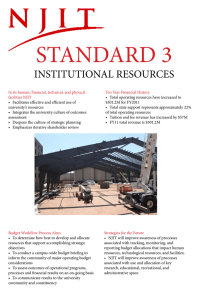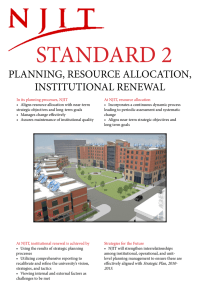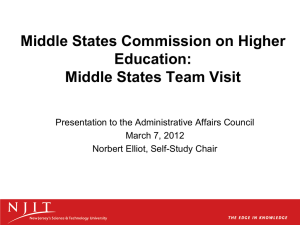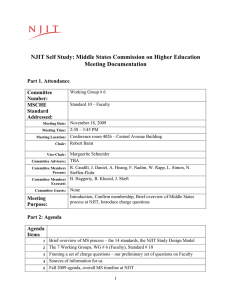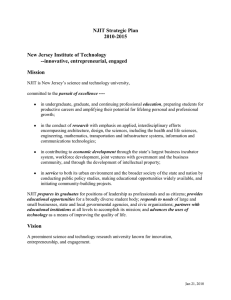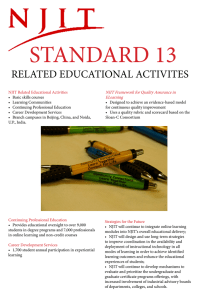STANDARD 7: INSTITUTIONAL ASSESSMENT
advertisement
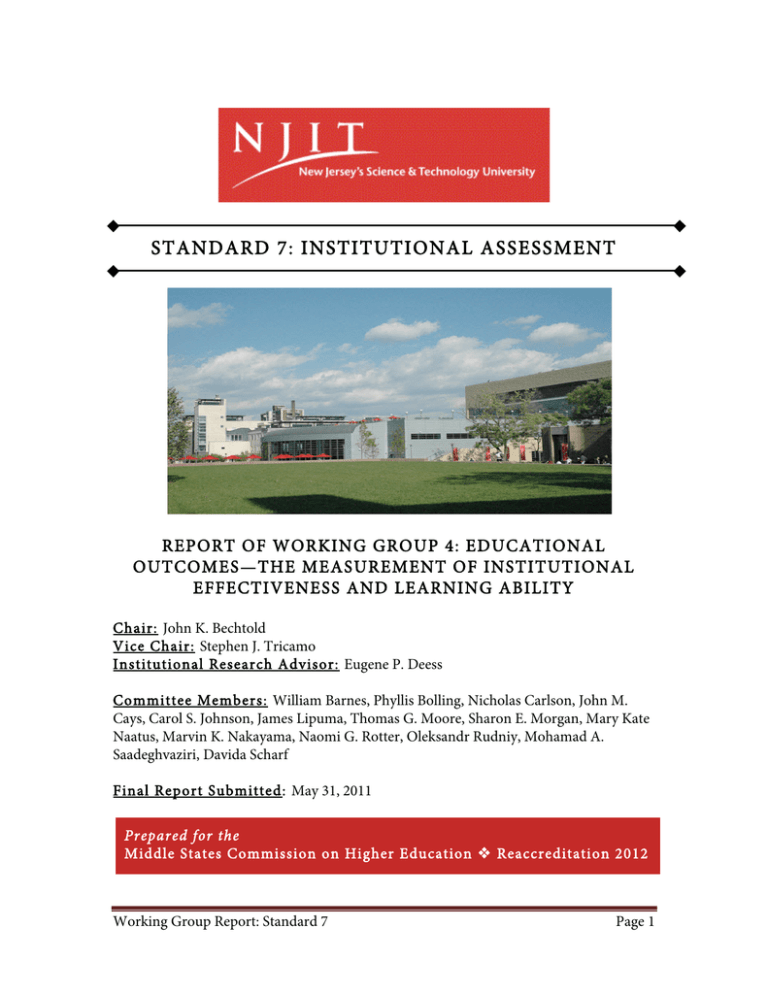
STANDARD 7: INSTITUTIONAL ASSESSMENT REPORT OF WORKING GROUP 4: EDUCATIONAL OUTCOMES—THE MEASUREMENT OF INSTITUTIONAL EFFECTIVENESS AND LEARNING ABILITY Chair: John K. Bechtold Vice Chair: Stephen J. Tricamo Institutional Research Advisor: Eugene P. Deess Committee Members: William Barnes, Phyllis Bolling, Nicholas Carlson, John M. Cays, Carol S. Johnson, James Lipuma, Thomas G. Moore, Sharon E. Morgan, Mary Kate Naatus, Marvin K. Nakayama, Naomi G. Rotter, Oleksandr Rudniy, Mohamad A. Saadeghvaziri, Davida Scharf Final Report Submitted: May 31, 2011 Prepared for the Middle States Commission on Higher Education Reaccreditation 2012 s Working Group Report: Standard 7 Page 1 TABLE OF CONTENTS 7.0 W ORKING GROUP ASSESSM ENT CHECKLIST FOR STANDARD 7 3 7.1 INTRODUCTION 3 7.1.1 Précis: The Strategic Plan and the ViSTa Model 7.1.2 An Overview of Group 4’s Standard 7 Charge and Questions Addressed 3 4 7.2 SELF STUDY INQUIRY AND OUTCOM ES 4 7.2.1 ViSTa (Vision – Strategy – Tactics) A Strategic Planning Process for NJIT 7.2.1.1 Shareholder Model for NJIT Institutional Assessment Table 7.2.1.2 Plan Assessment 7.2.2 The NJIT Strategic Plan, 2004-2010 7.2.3 The NJIT Strategic Plan, 2010-2015 7.2.4 Institutional Assessment 7.2.4.1 Efficiency Table 7.2.4.2 Performance Based Salary Increase Data System 7.2.4.3 Course Evaluation 7.2.4.4 Surveys 7.2.4.5 Benchmarks 7.2.4.5.1 NJIT Public and Private Benchmark Universities Table 7.2.4.6 Summary of Individual Assessments within Each Accreditation Standard 4 5 6 7 7 8 8 8 8 10 13 13 14 7.3 CRITICAL ANALYSIS 15 7.4 COLLABORATION W ITH OTHER W ORKING GROUPS 16 7.5 RECOM M ENDATIONS FOR IM PROVEM ENT 16 7.5.1 Recommendations Table: Standard 7: Institutional Assessment 16 Working Group Report: Standard 7 Page 2 7.0 WORKING GROUP ASSESSMENT CHECKLIST FOR STANDARD 7 FUNDAMENTAL ELEMENTS OF INSTITUTIONAL ASSESSMENT (Characteristics of Excellence in Higher Education: Requirements of Affiliation and Standards of Accreditation. Philadelphia, PA: MSCHE, 2009) documented, organized, and sustained assessment process to evaluate and improve the total range of programs and services; achievement of institutional mission, goals, and plans; and compliance with accreditation standards that meets established MSCHE criteria evidence that assessment results are shared and discussed with appropriate constituents and used in institutional planning, resource allocation, and renewal (see Standard 2: Planning, Resource Allocation, and Institutional Renewal) to improve and gain efficiencies in programs, services and processes, including activities specific to the institution’s mission (e.g., service, outreach, research) written institutional (strategic) plan(s) that reflect(s) consideration of assessment results. TEAM EVALUATION 4=EXEMPLARY 3=EMERGING EXCELLENCE 2=MEETS STANDARD 1=DEVELOPING COMPETENCY 2 3 3 7.1 INTRODUCTION 7.1.1 Précis: The Strategic Plan and the ViSTa Model Following the NJIT model of strategic planning praised in the 2007 review of the NJIT Periodic Review Report, the centerpiece for NJIT’s present institutional assessment is the Strategic Plan, 2010-2015. The strategic plan, developed using the ViSTa planning process described below, contains the metrics required to assess progress toward objectives, and identifies tactics as well as the senior administrators responsible for allocating the resources necessary to achieve the specific objectives. The occasion of the Middle States Commission on Higher Education (MSCHE) self study has been a welcome occasion to strengthen NJIT assessment efforts for use in assessing Working Group Report: Standard 7 Page 3 institutional goals. Each of the fourteen standards established by MSCHE includes an NJIT periodic assessment of effectiveness as one of its fundamental elements. Standard 7, the focus of our Working Group, builds upon all of these other accreditation standards. As such, a summary of the assessments within each standard is included here to assist in documenting conclusions about the institution’s overall achievement of its key goals. 7.1.2 An Overview of Group 4’s Standard 7 Charge and Questions Addressed To determine the extent to which NJIT has developed and implemented an assessment process that evaluates its overall effectiveness in achieving its mission and goals, the Steering Committee and Working Group 4 jointly developed the following charge questions: 1. How can NJIT best expand its university-wide assessment activities? (Sections 7.2.1 and 7.2.4.6) 2. What processes are in place to assure that NJIT’s comprehensive assessment plan serves as a guide to university-wide, cohesive strategic planning? (Sections 7.2.17.2.3 and 7.2.4-7.2.4.6) 3. How might NJIT’s comprehensive assessment plan for institutional effectiveness be described in its relationship to the strategic planning process? (Sections 7.2.1-7.2.3) 4. In what ways has NJIT’s institutional assessment resulted in authentic institutional renewal as a result of assessment reports and balanced scorecards? (Section 7.2.1.1) 5. How does institutional assessment inform the strategic planning process? (Sections 7.2.1-7.2.3) 6. How does institutional assessment influence resource allocation? (Sections 7.2.4.1 and 7.2.4.2-7.2.4.4) 7. What evidence exists that the NJIT community understands and embraces existing institutional assessment efforts? (Sections 7.2.1.1) 7.2 SELF STUDY INQUIRY AND OUTCOMES 7.2.1 ViSTa (Vision – Strategy – Tactics) A Strategic Planning Process for NJIT As discussed in Working Group Report, Standard 2, ViSTa provides a framework for the strategic planning process at NJIT (Altenkirch, The NJIT ViSTA Strategic Planning Model). NJIT faces many challenges, including changing demographics among its student population, increased competition for financial support from public and private sources, and rapid obsolescence of technology. An effective strategic plan can help the university adapt to - and thrive in - this rapidly changing environment. Specifically, strategic planning can help NJIT: • Create a vision of its desired future and a course of action for achieving that vision • Determine how it can obtain competitive advantage given the array of alternatives available to its customers and shareholders Working Group Report: Standard 7 Page 4 • Establish priorities and objectives • Make decisions about where to allocate scarce resources • Align the work of all its constituents around its objectives The ViSTa framework contains three core elements: • Vision: A statement of the fundamental purpose of the university, its principles, and mission. • Strategy: The methodology the university has chosen to use to achieve its mission. • Tactics: The specific actions the university has decided to take to implement its strategies. The strategic plan and its associated metrics is the key document to be used in assessing the university’s progress towards its future goals. The strategic plan was structured using a “top down—bottom up” shareholder model. The bottom up component is designed to elicit input from the university’s key shareholders including representatives from university faculty, researchers, administration, alumni, students, Board of Trustees, Board of Overseers, local and state government agencies, etc. The top down component was equally—if not more— important, as it was designed to ensure that the university selects a small number of strategic priorities on which it can focus to achieve its objectives. The following shows the structure used for implementing this top down—bottom up strategic planning process: 7.2.1.1 Shareholder Model for NJIT Institutional Assessment Table The shareholder model presented on Table 7.0 suggests the degree to which institutional assessment had penetrated through the institution. Table 7.0. The NJIT Institutional Assessment Shareholder Model Organizational Group Key Members Responsibilities Steering Committee University President Representative from shareholder groups, as determined by the University President Working Group Report: Standard 7 Coordinate and guide strategic planning process Participate in a series of planning workshops Draft the Vision Statement, Strategic Priorities, and Strategic Objectives Review input and make decisions Direct Institutional Research and Planning staff in creation of written strategic plan Page 5 Institutional Research and Planning Departm ent Heads and Key Shareholders Task Forces One task force organized for each strategic objective Additionally, one task force established to develop metrics Six to eight members per task force Institutional Research and Planning Planning staff Head of each faculty, research and administrative department One representative from the remaining shareholder groups, including: • Board of Trustees • Board of Overseers • Students • Alumni • State/local government Represent constituents (e.g., department members) by sharing information with them and soliciting their input Review and provide input to Vision statement Value proposition Strategies and objectives Faculty, researchers and administrative staff with appropriate expertise (e.g., if task force is established to develop tactics for obtaining bio-engineering talent ranked in the top 10% internationally, then task force members with expertise in recruiting and/or bio-engineering may be selected) Draft tactics/action plans Draft metrics Conduct environmental analysis Compile input, analyze trends Support Steering Committee, Department Heads, Task Forces 7.2.1.2 Plan Assessment The NJIT strategic plan includes a formal assessment component applied to every objective. In the 2004-2010 strategic plan every line included a quantitative benchmark with annual targets. These targets were used to evaluate effectiveness in plan implementation and track overall institutional performance. These formal targets were wrapped into an annual plan evaluation process where senior staff assigned a color coded assessment result. Resources in the following year were then tied to the formal assessment. This approach to strategic planning ties institutional assessment directly to the plan and monitors resource allocation on a regular basis. The 2010-2015 employs a less rigorously quantitative assessment model, but the use of targets remains, and the annual evaluation of progress remains directly tied to resource allocation. Working Group Report: Standard 7 Page 6 7.2.2 The NJIT Strategic Plan, 2004-2010 Objectives of the strategic plan put in place in 2004 have been met, including: • • • • • Completion of the Campus Master Plan, encompassing the NJIT Campus Gateway [Redevelopment] Plan now in the implementation phase; Successful completion of two special-purpose fundraising campaigns for Albert Dorman Honors College and Athletics; Increased national prominence of academic and research programs. For example, the doctoral program in the Department of Mathematical Sciences was rated by Academic Analytics in the top 10 nationally among 375 universities in Top Research Universities Faculty Scholarly Productivity Index for 2007; Substantial growth in the licensing of intellectual property; and Enrollment growth, including one of the largest freshman classes in history. A detailed year-by-year record of the progress in achieving each of the goals of the 20042010 Strategic Plan is given in the five Strategic Plan Progress Assessment Reports, also known as Milestone Reports, which are available from the digital database. The same approach is currently being used in tracking the progress of the 2010-2015 strategic plan. 7.2.3 The NJIT Strategic Plan, 2010-2015 NJIT provides accessible, affordable education for the scientific and technological professions to a diverse student body, delivers practical research results to its sponsors, and is an active participant in the life of the community in which it lives. More than one hundred individuals from all sectors of the university community were involved in developing the plan. The plan includes the following highlights. NJIT is New Jersey’s science and technology university. It is committed to the pursuit of excellence in: • service to both its urban environment and the broader society of the region, state, and nation; • undergraduate, graduate, and continuing professional education; • the conduct of research with emphasis on applied, interdisciplinary efforts; • contributing to economic development of the state. Strategic Priorities and Objectives: • Enhance the quality of academic and campus life for the university community. • Sustain a base of private support. Working Group Report: Standard 7 Page 7 • Be nationally recognized for thematic core areas of integrated research and learning in: Alternative Energy; Sustainable Systems; Applied Life Science and Engineering; Healthcare Systems; Digital “Everywhere.” • Be nationally recognized for attracting high achieving students and faculty from diverse populations. A six-page, ViSTa-based chart outlining the developmental process for the strategic plan was developed and is contained in the digital database. It defined thirteen task forces with corresponding objectives for each one. Each objective was supplemented by specific tactics and included metrics for each tactic that will be used in the assessment process. Also listed are the members of the upper administration that will be responsible for allocating the resources needed to realize each objective. 7.2.4 Institutional Assessment Beyond specific initiatives identified in the strategic plan, institutional assessment at NJIT operates through a broad range of mechanisms including surveys, internal data analyses, and benchmark comparisons. Those discussed here are all regular reports; in addition there are numerous reports provided as requested. Ad hoc reporting is not addressed in this document; accompanying materials include a selection of these reports. 7.2.4.1 Efficiency Table The most comprehensive assessment tool for academic resource allocation is the Efficiency Table. This comprehensive table combines teaching load, budget, and research productivity reports into a clear set of normalized metrics for each academic unit. The report offers a simple tool for the analysis of management effectiveness at the academic unit level. As an annual report prepared for the past five years, longer term trends in departmental efficiency are made clear and resource allocation can be rationalized. 7.2.4.2 Performance Based Salary Increase Data System Beginning in FY 2010 all academic salary increases were handled through a quantified system that incorporates teaching, research, scholarly, and service activity. All faculty are awarded specific numeric values based on a formula combining their teaching evaluations, research expenditures from external sources, and scholarly productivity, and service to the university. This single metric is used as the primary basis to determine salary increases. Deans retain a small portion for discretionary increases; 90% is awarded through this formalized system that applies equally to all faculty in all departments. 7.2.4.3 Course Evaluation Course evaluations are a backbone of institutional assessment because they offer the most direct means of assessing the quality of the educational product as perceived by the Working Group Report: Standard 7 Page 8 students. They are not a tool for assessing student learning outcomes but they are critical for managing the quality of classroom delivery. Background Since 1999, Newark College of Engineering, the College of Science and Liberal Arts, the College of Architecture and Design, and School of Management and College of Computing Sciences have used uniform, university-wide course evaluations for both faceto-face and distance-learning courses. The evaluation includes detailed items relative to the assessment of instruction, the course, course facilities or software/web-platform for distance learning, technology/media use, and student self-assessment. It employs a uniform 5 point rating scale for the entire university. Reports of results are provided to each faculty member (for his or her own courses), department chairs, deans of the schools/colleges, the provost, and the president. In spring 2009, all courses (face-to-face and distance learning) are being evaluated via the web. Screenshots of each course evaluation with comments are emailed directly to faculty within two weeks of final grading. All classes for both the fall and spring semester, in all of the university’s schools/colleges, are included in the evaluation process. The data are processed centrally by the IRP office, including analysis and reporting of results. NJIT currently runs over 1,400 classes in the fall, and approximately 1,300 in the spring. The NJIT online course evaluation response rate for face-to-face courses is around 63% and the distance learning response rate is about 70%. These respond rates are well above the national averages. To assure that course evaluation questions are related to the assessment purposes, analysis was performed of item validity and reliability, and then research was conducted to study the links between results for instruction, other aspects of the course, and student characteristics and demographics. Crystal Report software is used to make reports clear and attractive to a broad and large constituency, including faculty, department chairs, deans, the provost and the president. The Office of Institutional Research and Planning aggregates the information on the forms and prepares and distributes electronic reports via a secured server to the Provost and Deans who distribute to their respective departments. The university-wide course evaluation process is driven by four main objectives: 1) achievement of consistency and reliability in the process, (2) maintaining strict confidentiality of faculty and students, (3) achieving maximum participation, and (4) a reporting process maximizing applicability of results. Applications A university-wide system has allowed each college to benchmark its courses against other technical courses, programs and the university overall. Starting in Fall 2010, the data from the course evaluation (Fall 2009/Spring 2010) were used in the performance-based Working Group Report: Standard 7 Page 9 pay process for all tenured/tenure track professors and university lecturers. Teaching was one of four factors in allocation of raises. The other three factors were: scholarship, funded research, and service to the university, the profession and the community. Teaching accounted for 45% of the faculty’s merit score, the other three areas contributed to the remaining 55%. Traditionally, course evaluations have been for faculty development. Results are reviewed by faculty, chairs and deans, and these individuals can identify the need for development and guidance for particular individuals. The colleges have instituted faculty development workshops, and established mentoring programs that pair master teachers with junior faculty. Media services in conjunction with Extended Learning Delivery and the schools/colleges offer workshops in Distance Learning course development to educate and assist faculty about the technology to develop and optimize distance learning course instruction. In addition, the university has come to rely on course evaluations as a meaningful component of the promotion and tenure process, as well as in course assignments, placement, and reappointment of adjunct faculty. The IRP office has also increasingly been asked to provide results for faculty being considered for special awards and recognition. 7.2.4.4 Surveys NJIT also employs a comprehensive survey protocol designed to assess regularly institutional effectiveness. The Office of Institutional Research and Planning conducts all surveys via the web and analyzes the data. With the acquisition of new survey software (WASurvey) in February of 2008, IRP staff programs all of its surveys without using the manpower or resources of UIS. IRP has expanded its established annual survey schedule: (a) Entering Students Surveys: In Fall of 2006, IRP began deploying an Entering Graduate Student Survey in addition to the established Undergraduate Entering Student Survey. The surveys consist of questions concerning students’ goals, enrollment decision, NJIT’s admission process, financial aid, student orientation and placement. The results of the Entering Students Surveys has: • Helped the Admission office to achieve record enrollments • Made NJIT’S financial aid offerings more competitive • Identified recruitment strategies effective with the current enrolling freshman class • Increased our understanding of the risk factors associated with success in persistence and graduation for the entering freshman class and created a baseline for research on retention • Indentified changes in the enrolling freshman class longitudinally • Instituted new nationally normed placement exams for incoming freshman Working Group Report: Standard 7 Page 10 A parallel Enrolling Student survey for graduate students was also created to gather a profile of incoming graduate students and information on their decision to enroll in NJIT. (b) Student Satisfaction Survey: Student Satisfaction Survey is deployed in the spring semester and is composed of a standard set of 30 questions about academic program, advising, student services, campus life, facilities and computer support. It is the flagship survey of the survey schedule and has the most impact because it contains a new issue driven module every year. In the past, the modules have addressed advisement, Greek and campus life issues, and library services. This year’s special module is being used to establish baseline metrics for the launch of Learning Communities in Fall 2011. Because the student satisfaction data are collected in real-time, NJIT has been able to muster additional resources to increase staff for the fall course registration advisement process and correct the perception of public safety (e.g., the NJIT police instituted a community policing model, “Coffee with the Cops” as well as personal security workshops.) The Student Satisfaction has resulted in: • Food services offering an “all you can eat” plan as well as Halal certified meat, Indian cuisine and the return of fast food favorite: Taco Bell • The redesign of the cafeteria • Establishment of a commuter lounge • The transformation and beautification of the NJIT campus • Plans for an additional parking deck This survey provides key metrics for the strategic plan and for the internal evaluation of services. (c) Graduating Student Survey: The graduating student survey includes items relating to achievement of goals, self-assessment of acquired skills and knowledge, evaluating academic programs and student services. Graduates are also asked to describe current employment and educational plans and expectations as well as demographic information about themselves. The information from the survey is reported to the schools and departments for continuous improvement of programs and accreditation. (d) Alumni Survey: In Fall of 2010, the Alumni Survey was extensively revised with input from Career Services, and departmental/school programs, especially Engineering Technology and the School of Management. It was changed from a three year to an annual schedule. It is administered to alumni, who graduated one, two and three years ago. They are emailed an invitation to participate in the online survey and are asked to reflect and comment on: • Relative strengths and weakness in their own academic achievements at NJIT Working Group Report: Standard 7 Page 11 • Preparation for careers and further education received at NJIT • Relative strengths and weaknesses of aspects of their academic programs and student services • General recommendations about NJIT to others • Employment status • Continuing learning experiences The data from this survey are used for accreditation and national ranking surveys. (e) Survey of Employers of NJIT Graduates and Survey of Employers of Coop/Intern Students: In Fall of 2010, the Employer Survey and Survey of Employers of Coop/Intern Students also was extensively revised with input from Career Services, and departmental/school programs, especially Engineering Technology and the School of Management. It was changed from a three year to an annual schedule. The employer is asked to rate the various skill sets (e.g., technological, mathematics, communication, interpersonal, ethics and professionalism) of NJIT graduates, or coop/intern student whom they have directly supervised or managed. They are also asked about their sources for recruitment of personnel. The data from this survey are used for accreditation and national ranking surveys and by NJIT’s Career Services division. (f) Study Aboard Survey: In 2009, the Study Aboard Survey was instituted. It is used to assess the study abroad experience, advisement, educational experience, housing, food, and personal safety issues. This survey has proved to be an invaluable resource for those who student who wish to study abroad. (g) Athletics Program and Exit Surveys: All team sports have to complete the Athletics Program and Exit evaluations that are mandated by NCAA regulations. The survey monitors the overall NJIT experience, scheduling, equipment, facilities, travel, coaches (head and assistant coaches), training, medical, insurance and diversity issues. (h) Honors College Survey: The Albert Dorman Honors College survey was added to our roster of annual surveys in spring 2011. It consists of 30 questions about the Honors College experience, honors courses, honors colloquia, interaction with faculty and students, scholarships, research opportunities and co-op and internships. (i) Various Ad hoc Surveys: In addition to the previous schedule of annual surveys, IRP is responsible for various ad hoc surveys: the Non-enrolling students (which is used in conjunction with the Entering Students Survey), Faculty Survey of Administration, Continuing Professional Education, the New Course Scheduling System, the Executive MBA program and Commencement, which led to a revision of graduation proceedings. Working Group Report: Standard 7 Page 12 (j) NSSE: The National Survey of Student Engagement (NSSE) is also a critical part of institutional assessment. It provides the most rigorous nationally benchmarked information about the process employed to deliver the curriculum. As a fundamental part of the Voluntary System of Accountability, NSSE will be discussed at length in Working Group Report, Standard 14. 7.2.4.5 Benchmarks To standardize institutional assessment and establish formal comparisons, NJIT Senior Staff has identified formal benchmarks for use in institutional assessment. These universities are shown in Table 7.1. Institutions were selected using the Carnegie Classification system and actual IPEDS data. Because no other public, diverse, selective, urban technical university exists, each benchmark reflects some characteristics shared with NJIT. All are predominantly STEM institutions with strong research profiles and doctoral programs. Some, such as Georgia Institute of Technology and Lehigh University, are aspirational peers, while others, such as Drexel and Stevens Institute of Technology, are selected because they share an applicant pool with NJIT. Analyzing the benchmark institutions offers guidance about trends and best practices in addressing the vicissitudes of higher education in the United States. As a regular assessment of NJIT performance, benchmark data are collected on selectivity, enrollment, retention, graduation, budget, financial aid, and revenue generated by tuition. Additional data are collected for institutional assessment as needed. 7.2.4.5.1 NJIT Public and Private Benchmark Universities Table Table 7.2 shows the NJIT public and private benchmark universities. Table 7.2: NJIT’s Benchmark Institutions Benchmark Institutions University Name Auburn University Main Campus Clemson University Colorado School of Mines Georgia Institute of Technology-Main Campus Michigan Technological University Missouri University of Science and Technology Montana State University Tennessee Technological University Texas Tech University The University of Tennessee at Chattanooga Working Group Report: Standard 7 Type Public Public Public Public Public Public Public Public Public Public Page 13 University of Alabama in Huntsville University of Alaska Fairbanks University of Louisiana at Lafayette University of Maryland-Baltimore County University of Massachusetts-Dartmouth University of Massachusetts-Lowell University of Vermont Virginia Polytechnic Institute and State University Public Public Public Public Public Public Public Public Drexel University Illinois Institute of Technology Lehigh University Rensselaer Polytechnic Institute Rochester Institute of Technology Stevens Institute of Technology Wake Forest University Worcester Polytechnic Institute Private Private Private Private Private Private Private Private 7.2.4.6 Summary of Individual Assessments within Each Accreditation Standard The ViSTa framework provides a template that is well suited to evaluate the Middle States Characteristics of Excellence in Higher Education. The Vision component is analogous to the characteristics of excellence for each of the fourteen standards. In the Working Group Report for each standard, the Strategy and Tactics used to achieve that vision are discussed in detail. The individual Working Groups have also included the specific metrics used to assess the corresponding standard. As discussed in Working Group Report, Standard 2, each objective is written in an assessable SMART format (S=Specific, M=Measurable, A=Actionable, R=Realistic, T=Time-based). Two tracking systems are used. The balanced scorecard uses a colorcoded scorecard while the milestone assessment report employs a target met, progress made, and opportunity for additional progress format (IRP, 1st through 6th Milestone.) The Working Group Reports on Standards 1 and 2 discuss the mission, goals, planning, resource allocation and institutional renewal embodied in Standards 1 and 2 (note that Working Group Report correspond directly to standard numbers). These criteria are reflected in the institute’s strategic plan. As discussed above, the objectives of the 20042010 strategic plan have largely been met and the ViSTa framework has successfully been used to formulate the new 2010-2015 plan with associated assessment metrics. The Working Group Report on Standard 3 uses a modification of ViSTa to address Institutional Resources. As shown in Chart I for the planning/budget workflow, an Working Group Report: Standard 7 Page 14 analysis of the annual budget is used to assess the plan and modify the strategic and tactical plans, as required. The Working Group Report on Standard 4 lists various shareholders involved in leadership and governance. Examples are the Board of Trustees, Advisory Boards for each of the colleges, the Faculty Council, the Student Senate, and the Graduate Students Association. These bodies form a checks and balances structure among the various constituencies and serve an assessment function in evaluating the effectiveness of Standard 4. Administration of the institute is addressed in the Working Group Report for Standard 5. As discussed above, the administrative function as codified in the new 2010-1015 strategic plan includes thirteen specific task forces and corresponding metrics to be used for assessment. One example is the annual student satisfaction survey. A significant change in administrative structure occurred in 2004 with the creation of the post of Associate Provost for Academic Affairs. This individual will be responsible for assessing and coordinating curricula across all of the educational units of the institute. As discussed in the Working Group Report for Standard 6, integrity is designated as a core value in the NJIT Strategic Plan. The report outlines the various agencies and departments with an interest in diversity, ethics, and integrity, including the creation of an Ethics Liaison Officer in 2008. Integrity and the faculty review process, the campus culture and the students provide metrics for the assessment of this standard. 7.3 CRITICAL ANALYSIS The Working Group Report for Standard 1 quotes the 2007 review by Katherine Mayberry and Herman Berliner conducted for the Middle States Commission on Higher Education: “Decision-making at NJIT is clearly driven by continuous assessment of institutional effectiveness at multiple levels, including comprehensive coverage of student learning outcomes. The thorough assessment mechanism that evaluates programs on all components of the Strategic Plan is but one instance of the thorough-going culture of evidence that characterizes the institution. More generally, NJIT lives the principle that policy and strategy should be continually reviewed and improved through ongoing assessment” (p. 7). It is important to recall that analysis in this Working Group Report because the ten year self study has taken the occasion of MSCHE review to strengthen and deepen the university’s institutional assessment efforts (Self Study Committee, An Emerging Presence). Indeed, as the report addressing Standard 14 makes clear, the university has now established a uniform assessment framework for both institutional effectiveness and assessment of student learning; indeed, the robust and effective impact of the former, in Working Group Report: Standard 7 Page 15 place at NJIT since the launch of the 2004 strategic plan, has influenced the later. As is clear, NJIT is dedicated to establishing a national model of quality improvement through an assessment process that includes a wide variety of shareholder dedicated to strengthening and deepening the NJIT mission of education, research, economic development, and service. 7.4 COLLABORATION WITH OTHER WORKING GROUPS In scheduled meetings hosted by the Rapid Assessment and Steering Committee, our Working Group collaborated with other groups. Collaboration was also strengthened through meetings with the self study consultant (Robert Clark). Asynchronous communication was fostered through the open source content management system (Moodle); in that platform, the Working Groups collaboratively reviewed each stage of the planning and reporting process, from question design to outlines of the Working Group Reports, to edited review, to final copy. 7.5 RECOMMENDATIONS FOR IMPROVEMENT 7.5.1 Recommendations Table: Standard 7: Institutional Assessment RECOMMENDATION 1 • VISION: The desired future for the recommendation • STRATEGY: The methodology recommended to achieve the vision TACTIC: The specific action recommended to implement the strategy • • ASSESSMENT: The metric recommended to measure achievement of the vision Working Group Report: Standard 7 More broadly disseminate the ViSTa model, along with other project management models, as strategies to enhance project tracking and success. All shareholders have an awareness and understanding of how the university operates and is managed. Make planning and management decisions effective, efficient and transparent. Develop a mechanism, such as a committee on planning and management to ensure all planning models include clearly articulated accountabilities, timelines, anticipated outcomes, follow-up mechanisms, and reporting strategies. Progress reports of committee planning and management activities will be made available in a timely manner on the web, to allow a forum for feedback from all shareholders for continuous improvement. Page 16 References Altenkirch, Robert et al. NJIT Strategic Plan 2010-2015. Newark: NJIT, 2010. Web. Altenkirch, Robert. NJIT Strategic Plan 2004-2010 (Revised). Newark: NJIT, November 22, 2005. Web. Altenkirch, Robert et al. The NJIT ViSTA Strategic Planning Model. Newark: NJIT, 2009. Web. Institutional Research and Planning. Reports, 2002-2011. IRP (Institutional Research and Planning). 1st Milestone (FY05) Strategic Plan Progress Assessment Report. Newark: NJIT, 2006. Web. IRP (Institutional Research and Planning). 2nd Milestone (FY06) Strategic Plan Progress Assessment Report. Newark: NJIT, 2007. Web. IRP (Institutional Research and Planning). 3rd Milestone (FY07) Strategic Plan Progress Assessment Report, Newark: NJIT, 2008. Web. IRP (Institutional Research and Planning). 4th Milestone (FY08) Strategic Plan Progress Assessment Report, Newark: NJIT, 2007. Web. IRP (Institutional Research and Planning). 5th Milestone (FY09) Strategic Plan Progress Assessment Report. Newark: NJIT 2010. Web. IRP (Institutional Research and Planning). 6th Milestone (FY10) Strategic Plan Progress Assessment Report. Newark: NJIT, 2011. Web. Self-Study Committee (NJIT Middle States Self-Study Steering Committee and Working Groups). An Emerging Presence: Self-Study and Strategic Plan 2002. Newark: NJIT, 2002. Web. Mayberry, Katherine and Herman Berliner. Report to Faculty, Administration, Trustees, Students of New Jersey Institute of Technology, University Heights, Newark, NJ Prepared Following Analysis of the Institution’s Periodic Review Report. MSCHE, 2007. Voluntary System of Accountability. Web. Working Group Report: Standard 7 Page 17
